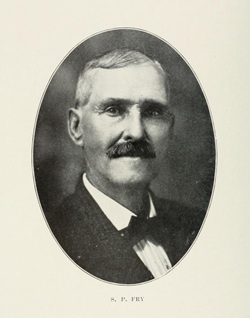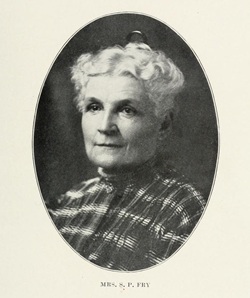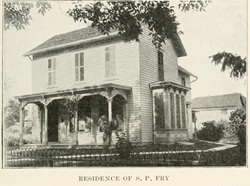| The
name of Fry has been identified with the business development of Iowa
City and northern Johnson county since 1840, in which year Titus and
Jane (Preston) Fry, the parents of our subject, settled in Johnson
County and took up land from the government, a part of which is the
site of the present village of Frytown. The parents were natives of
Ohio, and Samuel P. Fry was also born in the Buckeye state June 15,
1840, being barely six months old when his father and mother made the
westward journey to Iowa. Titus Fry was by trade a carpenter, but took
up farming after coming to Johnson County. He was a man of active mind,
abreast of the times, progressive and aggressive. Though he resided on
the farm in Washington township until 1865, then moved to Iowa City, he
nevertheless took an active interest in all matters pertaining to the
development and growth of Iowa City. He filled the office of justice of
the peace in his township for a number of years and various other
township offices. The children of Titus and Jane Fry were eight in
number: our subject; William A., president of the Iowa City Water Co.
and treasurer of the Boerner-Fry Co., Iowa City, and was president of
the Johnson County Bank, with which he has been connected for
thirty-two years; Mary Jane, now Mrs. Moore, living in Iowa City;
Rachel, now Mrs. Jacob Patterson, living in California; |  | Amanda, married to Samuel Olinger, she now deceased; Florence; Samantha; Carrie, deceased wife of Bert Wyman.
Our
subject attended the country schools of his home neighborhood, and
early in life began to farm. This business he continued for a number of
years after leaving school. Feeling a desire for work in the
city, he
removed to Iowa City, where he engaged in the grocery business for two
and one half years. Following this, he took up the livery
business for two years. He then returned to the farm west of Iowa
City, where he resided for nineteen years, or until he removed to his
present location about six years ago, to Iowa City, there for two
years, then bought 142 acres in East Lucas township, where he lived for
four years, them moved to his present home March 1, 1912.
Mr.
Fry was married on September 30, 1875, in Iowa City by Rev. D. P.
Grosscup, a brother of Mrs. Fry, and both are cousins of Judge
Grosscup, of Chicago, to Miss Fianna M. Grosscup, a native of |  | | Ohio.
She has borne him eight children: Hayes Allen, born October 10,
1876, married and living in Iowa City, one child, Margaret; Edna
Grace, born February 4, 1878, now
Mrs. Roscoe Wilson, of Iowa City, one child, Robert; Jessie May, born
March 10, 1880, now Mrs. Stoner, living near North Liberty, four
children,Helen F., Edna, Irma, and Samuel F.; Mary Edith, born march 1,
1882, wife of L. G. Beeson, engaged in the agricultural department,
Washington, D. C., two children, John A. and Edith V.;
Stella B., born September 25, 1885, now Mrs. William Rowland,
living four miles west of Iowa City, two children, Mabel and Gertrude;
Annastatia, born May 31, 1887, now Mrs. Ward Rowland, lives near her
sister Stella, west of Iowa City; Glenn G., born May 16, 1890,
unmarried, residing at home; Ella Leera, born August 20, 1892, now Mrs.
Lynn, of Ann Arbor, Michigan, one |  |
child, Laurance.
Our
subject was the owner of a fine home in East Lucas township, west
of Iowa City, which he sold in the fall of 1911, an engraving of which
is given in connection with this sketch. He is a
republican politically and in every sense a citizen of worth. He
has held the position of assessor, and has been prominently identified
with the Johnson County Agricultural Society. He and his entire family
are members of the Christian church.
(Source: Leading Events in Johnson County, IA, Cedar Rapids, Western Historical Press 1912-13; pgs.. 526 - 528)
|